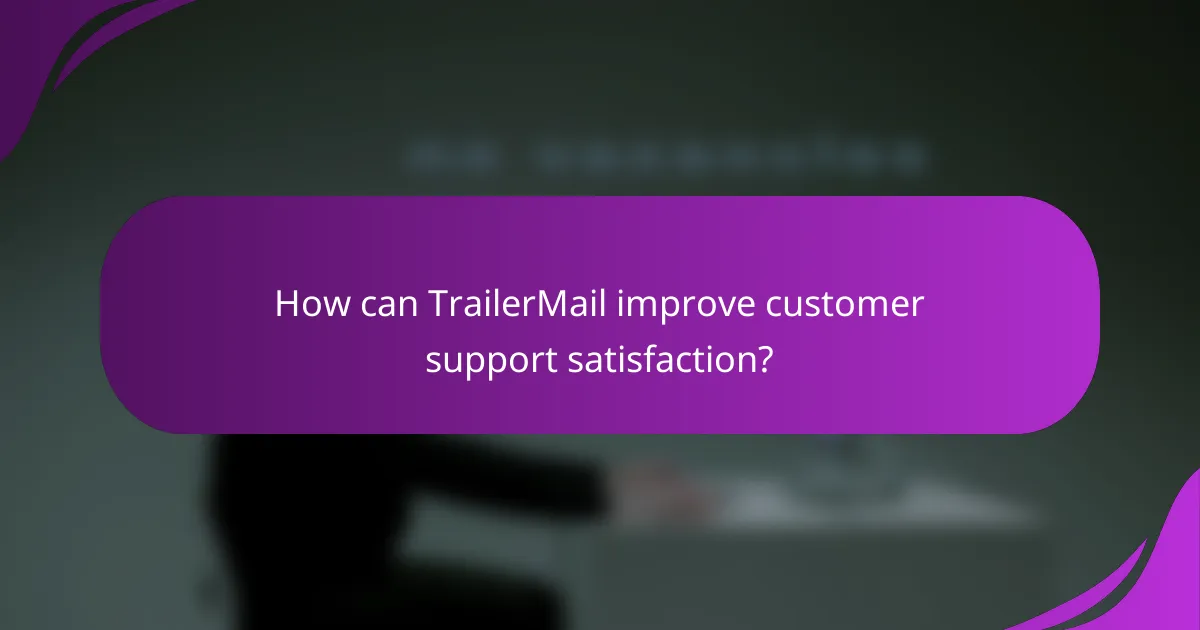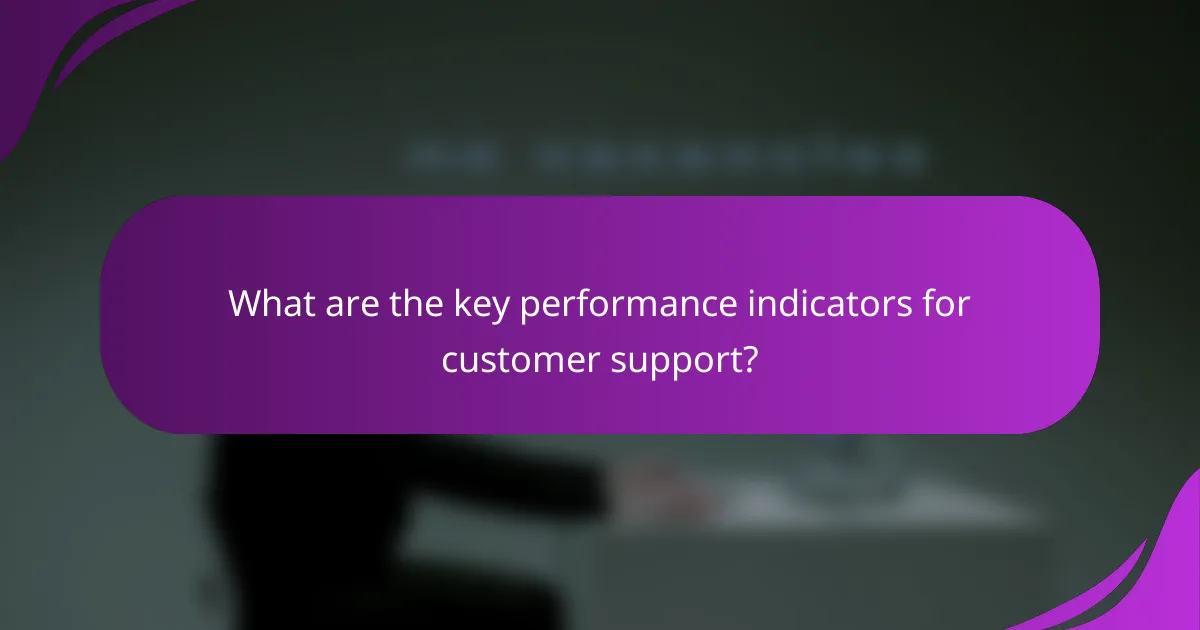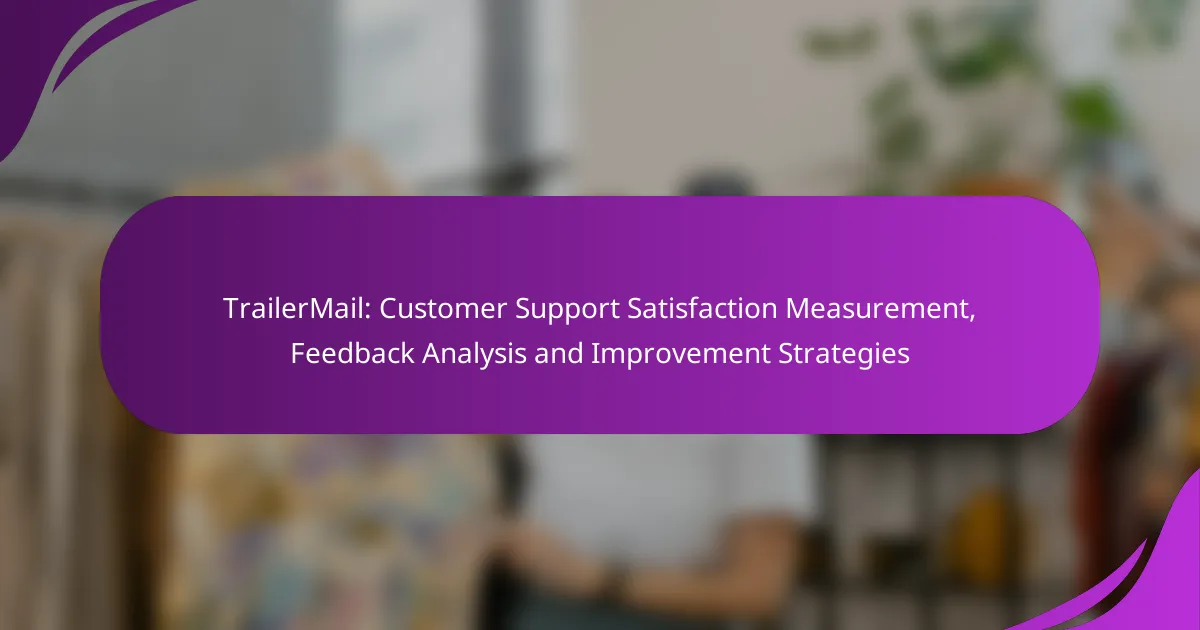TrailerMail focuses on enhancing customer support satisfaction by implementing robust feedback analysis and improvement strategies. By utilizing techniques such as sentiment analysis, customer satisfaction surveys, and Net Promoter Score tracking, TrailerMail effectively gauges customer experiences and identifies areas for enhancement. These efforts, combined with optimized response times and well-trained staff, contribute to a more responsive and effective support system tailored to meet customer needs.

How can TrailerMail improve customer support satisfaction?
TrailerMail can enhance customer support satisfaction by actively seeking and analyzing feedback, optimizing response times, and ensuring staff are well-trained. Implementing these strategies will lead to a more responsive and effective support system that meets customer needs.
Utilizing real-time feedback tools
Real-time feedback tools allow TrailerMail to gather customer opinions immediately after interactions. This can be achieved through post-interaction surveys or feedback forms integrated into the support platform. Quick responses help identify issues promptly and adjust strategies accordingly.
Consider using tools like in-app surveys or SMS feedback requests to capture insights. Aim for a response rate of around 20-30% to ensure a representative sample of customer experiences.
Implementing AI-driven analytics
AI-driven analytics can process large volumes of customer feedback to identify trends and areas for improvement. By leveraging machine learning algorithms, TrailerMail can analyze sentiment and categorize feedback efficiently. This approach helps in pinpointing recurring issues that may affect satisfaction.
Utilizing platforms that offer AI capabilities can streamline this process. Look for solutions that provide actionable insights and predictive analytics to anticipate customer needs and enhance service quality.
Enhancing response time metrics
Improving response time is crucial for customer satisfaction. TrailerMail should track metrics such as first response time and resolution time to identify bottlenecks in the support process. Aim for first responses within a few minutes and resolutions within a few hours for optimal satisfaction.
Implementing a tiered support system can help prioritize urgent issues, ensuring that customers receive timely assistance. Regularly review these metrics to set benchmarks and continuously improve performance.
Training support staff effectively
Effective training for support staff is essential for delivering high-quality service. TrailerMail should focus on both product knowledge and customer service skills. Regular training sessions and role-playing scenarios can prepare staff to handle various customer inquiries efficiently.
Consider establishing a mentorship program where experienced staff guide newcomers. This can enhance knowledge transfer and build a strong support culture, ultimately leading to better customer interactions.

What feedback analysis techniques does TrailerMail use?
TrailerMail employs various feedback analysis techniques to gauge customer support satisfaction effectively. These methods include sentiment analysis algorithms, customer satisfaction surveys, and Net Promoter Score (NPS) tracking, each providing unique insights into customer experiences and areas for improvement.
Sentiment analysis algorithms
Sentiment analysis algorithms analyze customer feedback to determine the emotional tone behind the comments. By processing text data from emails, chats, and social media, these algorithms classify sentiments as positive, negative, or neutral. This helps TrailerMail identify trends in customer emotions and pinpoint specific issues that may require attention.
For instance, if a significant number of customers express frustration in their feedback, it can trigger a deeper investigation into the underlying causes. Utilizing machine learning models, the algorithms continuously improve their accuracy, adapting to new language patterns and expressions over time.
Customer satisfaction surveys
Customer satisfaction surveys are structured questionnaires designed to collect direct feedback from users about their experiences with TrailerMail’s services. These surveys typically include a mix of quantitative and qualitative questions, allowing customers to rate their satisfaction on a scale and provide open-ended comments.
To maximize response rates, TrailerMail often sends these surveys shortly after customer interactions. This timing ensures that feedback is fresh and relevant. Analyzing survey results helps identify strengths and weaknesses in service delivery, guiding future improvements.
Net Promoter Score (NPS) tracking
Net Promoter Score (NPS) tracking measures customer loyalty by asking a single question: “How likely are you to recommend TrailerMail to a friend or colleague?” Respondents rate their likelihood on a scale from 0 to 10, allowing TrailerMail to categorize them into promoters, passives, and detractors.
Regularly tracking NPS provides a clear metric for customer loyalty over time. A high NPS indicates strong customer advocacy, while a low score signals potential issues. TrailerMail uses this data to implement targeted strategies aimed at converting detractors into promoters, ultimately enhancing overall customer satisfaction.

What are the key performance indicators for customer support?
Key performance indicators (KPIs) for customer support are essential metrics that help evaluate the effectiveness and efficiency of support teams. They provide insights into customer satisfaction, operational performance, and areas for improvement.
First response time
First response time measures how quickly a customer receives an initial reply after submitting a support request. This metric is crucial as it directly impacts customer satisfaction; a shorter response time often leads to a better customer experience.
To optimize first response time, aim for a target of under 5 minutes for live chat and under 1 hour for email responses. Regularly monitor and analyze this metric to identify trends and adjust staffing or processes as needed.
Resolution rate
Resolution rate indicates the percentage of customer issues resolved on the first contact. A high resolution rate suggests that support agents are effectively addressing customer needs without requiring follow-up interactions.
To improve resolution rates, provide comprehensive training for support staff and ensure they have access to the necessary resources and tools. Aim for a resolution rate of 70% to 90% to maintain high customer satisfaction levels.
Customer effort score
The customer effort score (CES) gauges how easy it is for customers to resolve their issues. A lower effort score correlates with higher customer loyalty and satisfaction, making it a vital KPI for support teams.
To enhance the customer effort score, streamline support processes and reduce unnecessary steps in the resolution journey. Regularly solicit feedback from customers to identify pain points and implement changes that simplify their experience.

How does TrailerMail integrate with existing tools?
TrailerMail seamlessly integrates with various existing tools to enhance customer support operations. By connecting with popular platforms, it streamlines communication and feedback analysis, making it easier to measure customer satisfaction.
API integrations with CRM systems
TrailerMail offers robust API integrations with major CRM systems like Salesforce and HubSpot. These integrations allow for automatic syncing of customer interactions and feedback, enabling support teams to access comprehensive customer profiles and history.
When setting up API integrations, ensure that the data flow is secure and compliant with relevant regulations, such as GDPR. Regularly review the integration settings to maintain data accuracy and integrity.
Compatibility with helpdesk software
TrailerMail is compatible with various helpdesk software solutions, including Zendesk and Freshdesk. This compatibility allows support teams to manage customer inquiries and feedback directly within their helpdesk environment, improving response times and service quality.
To maximize the benefits, consider training your team on how to leverage these integrations effectively. Monitor the performance of the helpdesk software in conjunction with TrailerMail to identify areas for improvement and ensure a smooth workflow.

What are the common challenges in measuring customer support satisfaction?
Measuring customer support satisfaction often faces several challenges that can skew results and hinder effective analysis. Key issues include inconsistencies in data collection methods and biases in customer feedback that can distort the true sentiment of customers.
Data collection inconsistencies
Inconsistencies in data collection can arise from varying methods used to gather feedback, such as surveys, interviews, or online reviews. Different platforms may yield different response rates and types of feedback, making it difficult to compare results accurately.
To mitigate these inconsistencies, standardize your data collection approach. For instance, using the same survey format across all channels can help ensure that you are capturing comparable data. Aim for a consistent sample size and timing to improve reliability.
Bias in customer feedback
Bias in customer feedback can occur due to several factors, including the timing of surveys and the framing of questions. Customers may feel more inclined to leave feedback after a particularly positive or negative experience, leading to skewed results.
To reduce bias, consider implementing a balanced approach to feedback solicitation. Use neutral language in surveys and ask for feedback at various points in the customer journey. Additionally, employing random sampling techniques can help ensure a more representative view of customer satisfaction.

What strategies can enhance feedback analysis?
Enhancing feedback analysis involves implementing structured methods to gather, interpret, and act on customer insights effectively. Key strategies include utilizing technology for data collection, establishing clear metrics for evaluation, and fostering a culture of continuous improvement.
Utilizing Technology for Data Collection
Leveraging technology can streamline the feedback collection process. Tools like online surveys, chatbots, and customer relationship management (CRM) systems can automate data gathering, making it easier to capture customer sentiments in real-time. For instance, using platforms like SurveyMonkey or Google Forms allows businesses to reach a broader audience quickly.
When choosing technology, consider the integration capabilities with existing systems and the ease of use for customers. A user-friendly interface can significantly increase response rates, ensuring you gather a representative sample of feedback.
Establishing Clear Metrics for Evaluation
Defining clear metrics is essential for effective feedback analysis. Metrics such as Net Promoter Score (NPS), Customer Satisfaction Score (CSAT), and Customer Effort Score (CES) provide quantifiable insights into customer experiences. These metrics help identify strengths and weaknesses in service delivery.
Regularly review these metrics to track changes over time and adjust strategies accordingly. For example, if NPS scores drop, it may indicate a need for immediate action to address customer concerns.
Fostering a Culture of Continuous Improvement
Creating a culture that values feedback and encourages improvement is vital for long-term success. Encourage team members to view feedback as an opportunity for growth rather than criticism. Regular training sessions can help staff understand the importance of customer insights and how to act on them.
Implementing a feedback loop, where customers see changes based on their input, can strengthen trust and engagement. For example, if customers suggest a new feature and it is implemented, communicate this change back to them to show their voices matter.
